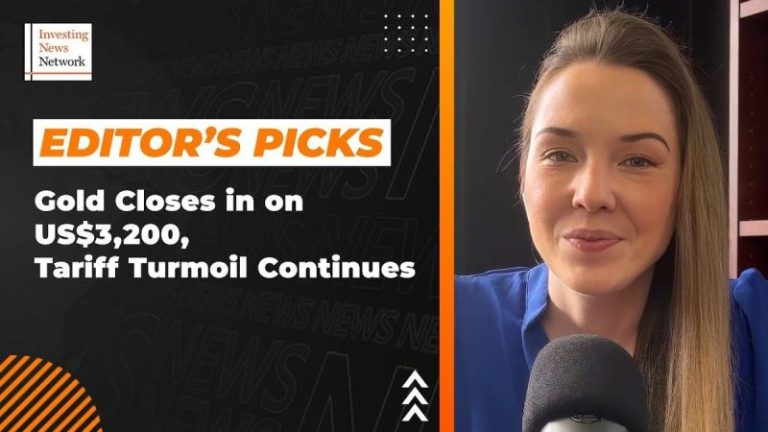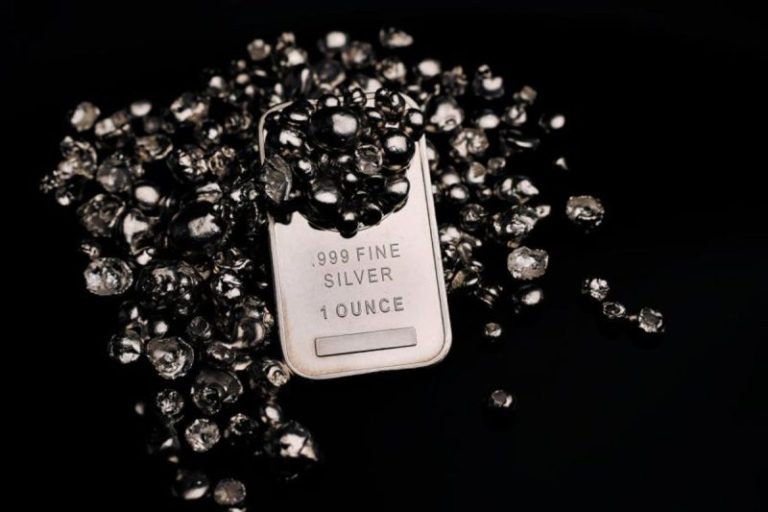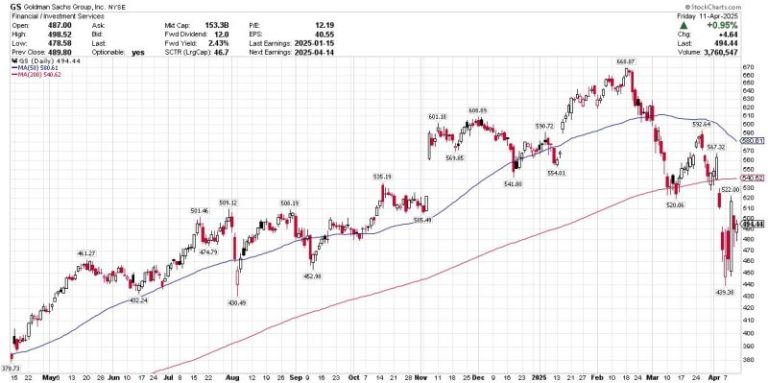The copper price began 2025 on a rebound, spending time above US$5 per pound during Q1 after trading within the US$4 to US$4.50 per pound range for most of 2024’s second half.
Starting strong, the red metal climbed from US$3.99 on January 2 to reach US$4.40 by mid-month.
It then eased slightly, ending January at US$4.25. February once again brought momentum as copper climbed steadily to US$4.76 on February 13. However, the price retreated and ended the month at US$4.53.
Copper price, January 2 to April 9, 2025.
Chart via Trading Economics.
The copper price saw significant gains throughout March, breaking through the US$5 mark on March 19. It set a new all-time high of US$5.22 on March 26 before falling to US$5.04 on March 31.
Since then, copper has been under pressure, and the price of the metal plunged to US$4.26 on April 7.
Copper market facing tariff uncertainty
The first quarter of the year was dynamic for copper, but few factors have influenced the market for the base metal more than the threat of tariffs from the US. This possibility has created a wider price gap between London Metal Exchange (LME) copper and Chicago Mercantile Exchange (CME) copper.
According to an ING article published in mid-February, the CME price was more than 10 percent higher than the LME price at the time, prompting traders to begin shifting copper inventories from overseas warehouses into the US.
This movement elevated stockpiles at CME warehouses to over 100,000 metric tons, the highest level since they peaked at 250,000 metric tons during Donald Trump’s first presidency.
Overall, the US relies on copper imports, which account for 45 percent of its domestic consumption. Chile constitutes 35 percent of incoming supply, while Canada contributes 26 percent.
The majority of copper inflows are in the form of refined copper products, which make up 60 percent of US imports.
On February 25, Trump signed an executive order invoking Section 232 of the Trade Expansion Act to initiate an investigation into the impact of copper imports on all forms on national security.
In the order, Trump noted that while the US has ample copper reserves, its smelting and refining capacity has declined. China has become the world’s leading supplier of refined copper, commanding a 50 percent market share.
During a mid-March CRU Group webinar focused on copper, Erik Heimlich, head of base metals at the firm, discussed why Trump may have announced the start of the investigation.
“Their reliance on imports has been growing systematically, and with the closure not so long ago of the Hayden smelter and the Amarillo refinery, that has increased even more,” he said.
Heimlich further explained that Trump may want to use copper tariffs to encourage a resurgence of copper processing in the US based on national security concerns. This point was reiterated by Bryan Billie, policy and geopolitical principal at Benchmark Mineral Intelligence, during a virtual panel held at the beginning of April.
“The big question here is whether US dependencies on copper imports are supposedly compromising national security. That’s the legal rationale behind the investigation,” Billie said.
He also discussed the timeline, noting that Section 232 investigations typically take 270 days to complete, although they can be shorter. While it remains uncertain whether the investigation will lead to tariffs, it could also result in export controls, which might pose additional challenges in global copper markets.
Michael Finch, Benchmark’s head of strategic initiatives, suggested that the review is likely to take weeks rather than months, and could actually bring some relief to the market.
“I think, given that the market now expects the announcement on Section 232 to arrive a bit sooner than previously anticipated, I don’t believe as much copper will be trapped in the US as we progress through the coming quarters … I think it’s part of that trend that we’re witnessing a softening in the copper price,” he said.
Supply chain disruptions and copper fundamentals
Other factors that have affected the copper price include a major power outage in Chile at the end of February.
Chile declared a state of emergency to address the outage, which left more than 8 million homes and a significant portion of the country’s mining operations without power.
The outage resulted from a transmission line failure in the northern part of the country, causing BHP (NYSE:BHP,ASX:BHP,LSE:BHP) to shut down operations at Escondida, the world’s largest copper mine.
Although power was restored in a few days, COMEX copper futures for March rose by 0.9 percent.
An additional supply disruption occurred in March, when Glencore (LSE:GLEN,OTC Pink:GLCNF) declared force majeure and halted copper shipments from its Altonorte operation in Chile. The refinery produces 350,000 metric tons of copper anode annually, and a prolonged shutdown could impact an already tight copper market.
On a fundamental level, the International Copper Study Group provided preliminary data for January’s supply and demand conditions on March 21. In its release, the group outlines an apparent deficit of 19,000 metric tons of refined copper in the first month of the year, down from the 24,000 metric ton deficit reported in January 2024.
Supply and demand for refined copper maintained a balance at the start of the year, with each growing by 1 percent. Supply-side growth was largely constrained by a 14 percent drop in Chilean output.
Mine production experienced a 2 percent increase in January, with 7 percent year-on-year growth from Peru. The ramp up of production at Anglo American’s (LSE: AAL,OTCQX:AAUFK) Quellaveco mine was a key factor.
Additionally, supply increased by 6 percent in the Democratic Republic of Congo due to the expansion of Ivanhoe Mines’ (TSX:IVN,OTCQX:IVPAF) Kamoa-Kakula mine. A 3 percent increase in Asian production was offset by a 2 percent decline in North America. Chile also saw a fall of 2.7 percent compared to the same period last year.
Copper price outlook for 2025
Copper is tied closely to the global economy, making this a key factor to watch.
“CRU economists continue to expect global GDP to grow by 2.6 percent in 2025, and refined copper demand to grow by around 2.9 percent in both this and next year, which is actually an increase compared to our previous forecast. So despite the dramatic macro and geopolitical events that we have witnessed over the last few months, the base-case demand narrative for copper remains robust,” Heimlich said in mid-March.
However, he also noted that this base-case scenario is surrounded by uncertainty.
That uncertainty has come to the forefront at the start of Q2. Copper prices fell nearly 20 percent at the beginning of April as the Trump administration announced a new round of base-level and reciprocal tariffs.
Investors experienced a significant selloff as the prospect of a recession became more pronounced.
A recession would substantially impact base metals, including copper, as consumers turn away from big-ticket items like new homes and cars, which require large quantities of these materials
For investors, uncertainty will likely remain for some time. A Section 232 outcome could help stabilize copper, or it could escalate other aspects of a trade war between the US and the rest of the world.
It also remains unclear how long Trump’s tariffs will be in place.
This situation could provide opportunities for investors with an appetite for risk who are looking to make bets. Others may prefer to remain on the sidelines and wait for more clarity on the global trade front.
Securities Disclosure: I, Dean Belder, hold no direct investment interest in any company mentioned in this article.










